Slowdown In US GDP Growth Does Not Mean Recession – 5 Reasons for Optimism in Spite of Slower Economic Momentum
February 23, 2016. New York, NY–“In times of heightened uncertainty, individuals tend to think in terms of extremes,” says Head of US Macroeconomics at Oxford Economics, Gregory Daco, in a new US economic research report released today. “However, the reality often lies in between these extremes. While we see a slowdown in US and global growth, we caution that does not entail a recession.” Daco recommends watching three factors closely in order to determine the risk of recession: consumer confidence, business confidence and banking sector confidence. He says while none are flashing red, some are amber.
US GDP Growth – Economy is not flat lining
Daco states that slower GDP momentum at the end of 2015 on the back of sluggish consumer outlays led to growing concerns that US households were retrenching. As a result many feared (and continue to fear) that this would presage an imminent recession. While the 0.7% advance in GDP growth was indeed disappointing – and more disappointment will come from the likely downward revision to 0.3% – it is important not to fall in the trap of extreme views in times of doubt. Indeed, reality often lies in the fifty shades of grey between black and white.
In order to do so, one must focus on the underlying reasons for the weak GDP performance at the end of 2015, and gauge economic momentum going forward. A major source of weakness at the end of 2015 came from slower consumer spending which grew a modest 2.2%. However, while the reading was a disappointment, both the underlying fundamentals supporting spending and the actual pace of outlays appear solid for five reasons.
First, employment remains solid with payroll growth averaging north of 200,000 jobs per month over the past year. Second, employment dynamics indicate a rising quits rate which points to more individuals on the look for better paying positions. Third, the unemployment rate (4.9%) and under-employment rate (9.9%) continue to decline, and we expect that even as payroll growth slows in a maturing labor market, the gains will be sufficient to reduce labor market slack. Fourth, reduced slack should feed into stronger wage growth (currently at 2.5% y/y) supporting income growth and thereby spending. Fifth, and this is perhaps the most important element, consumer spending is expected to rebound in the first quarter of 2016. Already, retail sales in January pointed to a solid start to the quarter in which we see consumer spending growth rebounding to around 3%.
“In short, while we did see a moderation in economic activity at the end of 2015, it would be unwise to assume that the next US recession is just around the corner,” says Daco.











